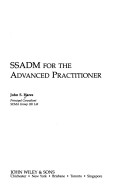Wiley Series in Software Engineering Practice
3 total works
Structured Systems Analysis and Design Methodology (SSADM) is a method for the design and analysis of computer systems developed following a commission from the UK Government's Central Computer and Telecommunications Agency (CCTA). While this review of SSADM is based on version three of the method, the version current in 1989, the suggestions for the application of and enhancements to the method are appropriate to the future. The book will provide an assessment of the strengths and weaknesses of SSADM, provide tricks of the trade in applying the SSADM techniques, procedures and standardize additional design techniques where, in the author's opinion, SSADM is deficient, and compare SSADM, where appropriate, to other competing structured design methods and review its current and likely position in the structured methods market place.
Rather than covering object orientation from the point of view of programming languages or design techniques, the authors focus on technology and techniques as well as the management implications of adopting and migrating to the object-oriented approach in the design and implementation of computer systems. This unusual generic approach has the advantage that readers will learn the generic facilities of the techniques and technologies and will therefore gain the maximum benefit of all the facilities currently available rather than the limitations of a particular structured method or object based language
This practitioner's guide examines the strengths and weaknesses of information engineering, a universally applied structured design method. Using practical case study examples, drawn from real-life experience, the book offers the experienced information engineer practical tips on how to use this method efficiently. It also gives advice on how the method can be expanded to support the distributed database and expert systems as well as object-oriented and real-time data processing environments.


